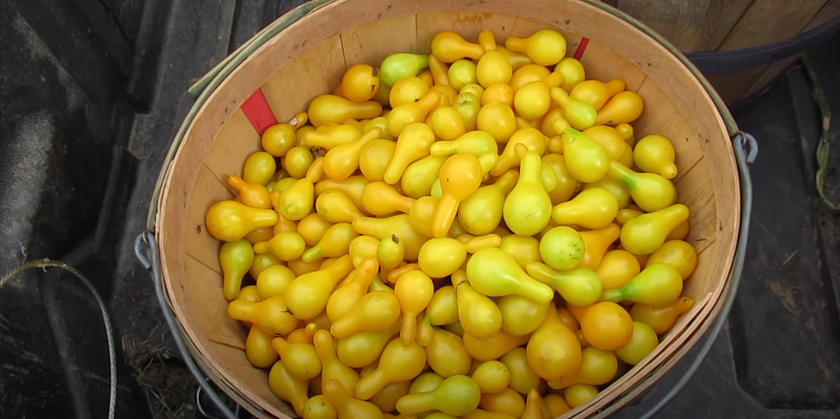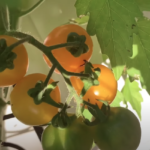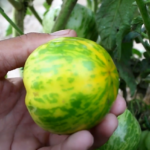Yellow Pear tomato is an indeterminate pear-shaped tomato which ripens with a bright yellow color. It is a small heirloom cherry tomato cultivar which is borne in clusters on long growing vines. The yellow pear is a mild flavored tomato used in salads, salsa making, pickling, canning and making preserves. The cultivar is very easy to grow and has moderate resistance to light blight tomato fungal disease.
Table of Contents
What is Yellow Pear Tomato
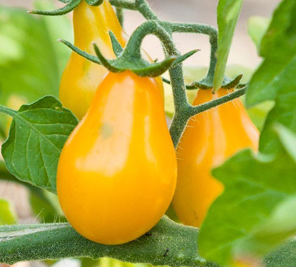
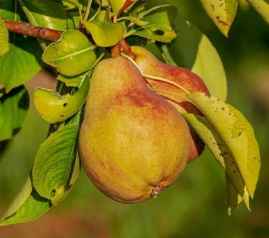
Although unusually shaped for a tomato and yellow colored when ripe, the yellow pear tomato is a legitimate member of Solanum lycopersicum species which is the same genus as regular red tomatoes and other red cherry tomatoes.
Furthermore, the yellow pear is a member of the Nightshade family where eggplants, potatoes, and peppers also belong. As much as the yellow pear is the most common variety, there are also orange and red pear tomato cultivars. The pear tomato takes its name from the popular pear fruit.
Yellow Pear Tomato Origins
Yellow pear tomatoes have origins in 18th century Europe where the first record of their cultivation was in 1805. In addition, historical records support the existence of the pear tomato in North America in 1825. The pear tomato variety has been noted by some historians as having been one of President Thomas Jefferson’s favorites. Interestingly, Thomas Jefferson is also known to have grown white eggplants in his garden.
According to the journal Theoretical and Applied Genetics, the elongated, pear-shaped and constricted neck features of the yellow pear can be explained by genetic mutation which is thought to have occurred during domestication and breeding process.
Researchers identified a certain gene that might have been responsible for the remarkable shape. In addition, most growers will notice that neck constriction of the fruit within the same plant can vary, with some fruit more constricted than others. According to the journal, this can be explained by fruit size, temperature and moisture conditions.
Yellow Pear Tomato Characteristics
The following table summarizes characteristics of the Yellow pear tomato.
| Botanical name – Solanum lycopersicum |
| Family – Nightshade family |
| Type – Open-pollinated cherry tomato |
| Breed – Heirloom |
| Origins – Genetic mutation |
| Shape – Pear-shape |
| Skin – Green when raw, Yellow when ripe |
| Flesh – Yellow |
| Flavor – Mild, sweet |
| Applications – salads, salsa, pickling, canning, preserves |
| Plant type – Indeterminate |
| Yield – very productive |
| Days to Maturity (DTM) – 75 to 80 days |
| Plant Height – 6 to 10 feet or 1.8m to 3m |
| Fruit Size – 2 oz. or 57 grams |
Convenient Tomato Kitchen Utensils
Once you have harvested your Yellow pear tomatoes, there are many things to do with them. Here are some handy kitchen utensils that help expand horizons when working with your picked yellow pear tomatoes and any tomato variety.
- Tomato strainer
- Tomato/Salsa Blender
- Food Processor for Tomatoes
- Tomato press
- Tomato mandoline for slicing
- Tomato slicer holder
- Heavy duty tomato slicer
- Tomato dicer
- Tomato corer
- Tomato jars for canning
- Tomato knife
- Tomato saver
- Countertop storage basket
- Tomato growing pots
Yellow Pear Tomato Nutrition and Benefits
Yellow pear tomatoes have nutritional benefits that, for the most part, mirror regular red domesticated tomatoes of the Solanum lycopersicum species. Apart from the pear-shape typical of the Yellow pear tomato, Yellow pears have similar nutritional content to yellow round tomatoes.
According to WebMD, all tomatoes regardless of color contain four main carotenoids namely alpha and beta-carotene, lutein, and lycopene. Carotenoids are yellow, orange, or red fat-soluble pigments which give color to ripe tomatoes and other vegetables such as yellow peppers and red peppers. Although each of these carotenoids carry individual health benefits, they also interact as a group in offering health benefits in humans.
Of the four carotenoids, Yellow pear tomatoes (and other yellow tomatoes) are believed to have a higher concentration of lutein, a xanthophyll which produces the yellow pigmentation in yellow tomatoes. Furthermore, according to the journal Acta Horticulturae, lutein is a crucial nutritional compound in the human diet shown to hinder age-related eye problems and other eye diseases.
Certain in vitro studies have also shown that increased intake of lutein as found in Yellow pear tomato has a promising protection against thickening or hardening of arteries brought about by a buildup of plaque in the inner lining of the arteries. Since these studies are in vitro (conducted in labs) it is yet to be established if a similar outcome could be observed in real life.
Apart from nutritional and functional health benefits directly associated with lutein in yellow tomatoes, by virtue of being tomatoes, yellow pears offer other nutritional benefits as those similarly found in regular red tomatoes. For example, Yellow pears offer vitamins A, C and E. They are also rich in potassium which plays an important role in the regulation of fluid balance, muscle contractions and nerve signals in the human body.
According to the journal Cancer Research, a combination of broccoli and tomatoes was shown to be more effective at slowing cancer related tumor growth than either tomato or broccoli consumed by itself. This makes a case of serving yellow tomatoes with a variety of other vegetables for maximum health benefits.
Finally, one most talked about benefit of Yellow pear tomatoes and some yellow tomatoes in general is their low acidity. Yellow pears have lower acid compared to red tomatoes. This makes them better suited for some individuals who find red tomatoes too acidic and unsettling for the digestive system.
Yellow Pear Tomato Seeds
Similar to other tomato cultivars and varieties, Yellow pears can be propagated using tomato plant stems or seed. Seed can be saved from earlier harvested yellow pear tomatoes or can also be commercially procured.
Planted from seed, yellow pear tomatoes take up to 75 days to reach maturity. To cut on time to maturity, instead of buying seeds there is also an option to buy transplants from certain seed suppliers. This will gain the grower some weeks in the season.
Yellow pear tomato seeds are widely accessible in North America. The following are some suppliers.
- Yellow Pear Tomato via Amazon
- Burpee Yellow Tomato Pear seeds
- Beam’s Yellow Pear Seeds by Seed Savers Exchange
- Baker Creek Yellow Pear Seeds
- McKenzie Yellow Pear Tomato Seeds
- True Leaf Market Yellow Pear Seeds
- Victoriana Nursery Gardens Yellow Pear Tomato Seeds (UK)
- Territorial Seed Company Yellow Pear Seeds
- Hudson Valley Seed Yellow Pear Cherry Tomato Seeds
Yellow Pear Tomato Recipes
The primary application of Yellow pear tomatoes is culinary in a variety of recipe preparations. Yellow pears are bite size tomatoes which have a rather mild but sweet flavor profile and are less acidic than regular red tomatoes, as earlier mentioned. These tomatoes are suitable for making Yellow pear tomato paste, salads, salsa, pickling, canning and preserves.
The following are some delicious recipes to try out that utilize yellow pears.
Pickled Yellow Pear Tomatoes Recipe
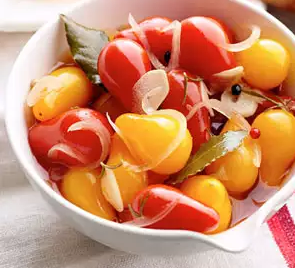
This recipe produces 7.5 pints or 3.5 liters of tasty pickled yellow pears. Unlike other pickling recipes, this recipe brings in a combination of rosemary and garlic in the flavor profile. You are free to use yellow pears in combination with red pear tomatoes and other tomatoes such as round cherries and Romas in this recipe.
Other ingredients will be sweet onions such as Maui Onion or Vidalia. Whole black, white and pink peppercorns will also be used in this recipe alongside white balsamic vinegar (example). This recipe takes about 50 minutes to prepare and 60 minutes in total. Some pickling jars (examples) will be required to accommodate the 7.5 pints output of this recipe. View Recipe.
Yellow Pear and Cherry Tomato Salad Recipe
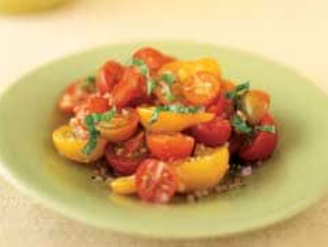
This recipe by Mayo Clinic taken out of The New Mayo Clinic Cookbook produces a 47 calorie salad per 3/4 cup. The recipe serves 6 and delivers a low fat, low carb and low sodium dish. Furthermore, the combination of Yellow pear tomatoes and red cherry tomatoes in the salad brings more than color to the table.
It also brings nutrition and health benefits associated with tomatoes as earlier discussed (see nutrition and benefits section). Other ingredients making it into the recipe include extra-virgin olive oil, sherry vinegar or red wine vinegar, fresh basil leaves and shallots. The recipe is in two parts, the vinaigrette and the salad. View Recipe.
Summer Tomato Salad Recipe
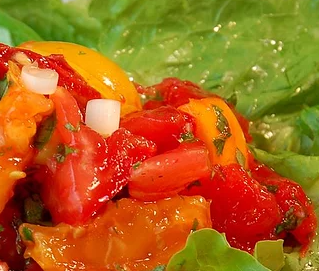
This is a simple 110 year old tomato salad recipe that makes use of Yellow pear tomatoes and red cherry tomatoes. Other ingredients will be green onions, minced garlic, fresh basil, cilantro and red and black pepper to taste among others. The recipe yields 6 servings.
Before serving, the salad is refrigerated for some 30 minutes. The salad is served on green lettuce leaves such as buttercrunch lettuce or Boston lettuce. Our suggested twist to this recipe is using purple lettuce if you so wish. View Recipe.
English Cucumber Yellow Pear Tomato Salad Recipe
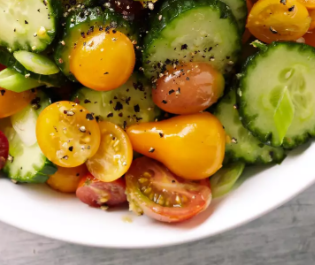
This simple recipe combines Yellow pear tomatoes, red grape tomatoes and freshly picked yellow cherry tomatoes with English cucumbers to create a scrumptious looking tomato and cucumber salad that serves 10. The cucumber is used with its skin on so you would need a bitterless cucumber.
The English cucumber is an example, which has thin skin that is easy to digest. You could also use lemon cucumber, Persian cucumber or Armenian cucumber in this recipe. We recommend using a mandoline (example) for slicing the cucumber as it produces aesthetically pleasing slices. This recipe takes a total of 1 hour 30 minutes to make on account of 1 hour chilling time before serving. View Recipe.
Roasted Potatoes and Pear Tomatoes Recipe
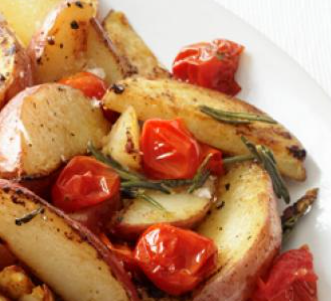
This recipe will produce a filling dish that yields 4. It is an easy dish and only takes 35 minutes to make. There are two main twists to this dish that we suggest. Instead of using red cherry tomatoes as listed in the recipe, we replace those with Yellow pear tomatoes.
You could, however, use both pear tomatoes and cherry tomatoes with no problem. We also suggest replacing red skinned potatoes with white potatoes such as Kennebecs in pursuit of the health benefits. Everything else and all the other ingredients in this scrumptious recipe remain the same. View recipe.
Yellow Pear Tomatoes Salsa Recipes
Yellow pear tomatoes are highly suitable for use in making great tasting salsas. The resulting paste can be used as spaghetti, noodles or pizza salsa and could even be applied to the popular Mexican dish Chilaquiles rojos or red Chilaquiles. Yellow pears can also be mixed with red tomatoes or pink tomatoes to make colorful salsa recipes.
The following are some delicious salsa recipes to try out.
Yellow Pear Tomato Salsa Recipe
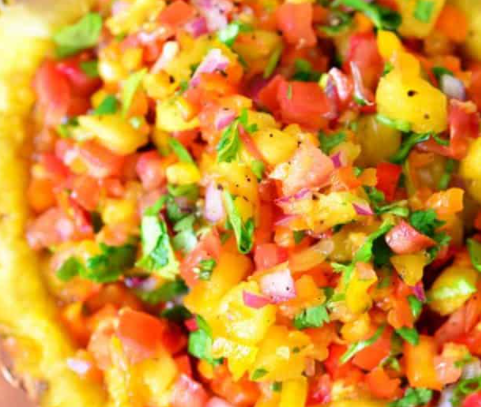
This is a simple salsa recipe made using Yellow pear tomatoes and regular red tomatoes. Other ingredients include sweet onion, garlic cloves, fresh cilantro, lime juice and jalapenos with seeds removed. The peppers play an important role in giving the salsa some character and depth.
The seeds are removed from the peppers before use to prevent them interfering with the salsa texture. All the ingredients are combined and then refrigerated for about an hour. The recipe serves 4 to 6. View Recipe.
Homemade Chili Powder Pear Tomato Salsa Recipe
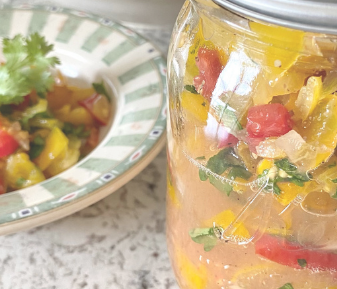
This is yet another salsa recipe made using Yellow pear tomatoes. This recipe has many of the ingredients used in the foregoing recipe. It will take some yellow pears and a red tomato, some cilantro, sweet onion, garlic and lime juice.
However, there is a twist to it introduced by a secret ingredient that we do not see often added to salsa recipes. After everything has been combined, the jars with the salsa are left to sit in the refrigerator for an hour before use. View Recipe.
Ground Cumin Yellow Pear Tomato Salsa Recipe
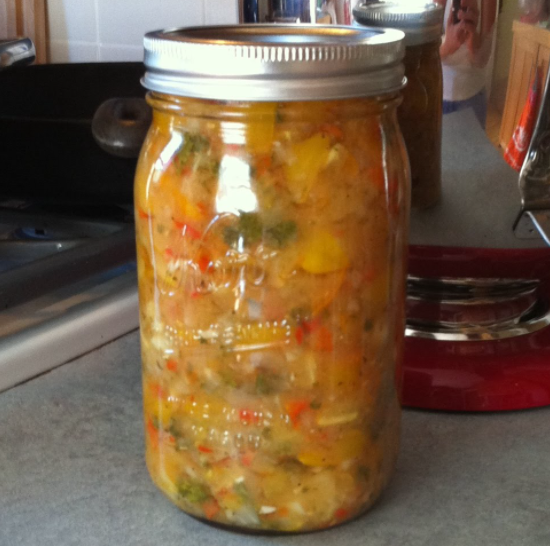
This Yellow pear tomato salsa recipe was developed from scratch by a home gardener. It is a delicious original recipe which produces a mild salsa. Instead of using hot peppers or any peppers of any kind with some sting, this recipe calls for red bell peppers. The yellow pear tomatoes and peppers used in this recipe are deseeded first.
Another interesting twist to this salsa recipe is the inclusion of cucumber. Not many salsa recipes that we know include cucumbers. Finally, another angle to this recipe is the ground cumin. Cumin brings a slightly sweet, warming flavor with a nutty element and is added generously to the salsa. View Recipe.
Winter Cherry and Pear Tomato Salsa Recipe
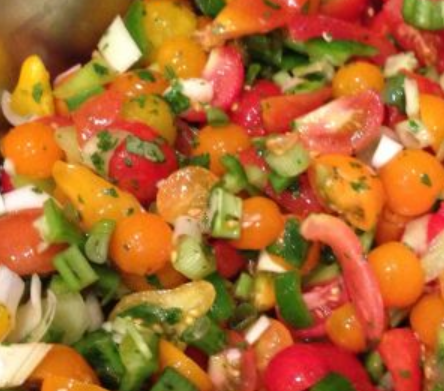
If you had a huge picking of Yellow pear tomatoes and you did not know what to do with it, this recipe offers a potential escape avenue. Make enough salsa for winter following this simple recipe. Simply freeze the jars not being used immediately and draw on them throughout the winter season when your garden is no longer producing.
This recipe calls for a mix of cherry tomatoes and yellow pears. Other ingredients will be green onions, cilantro, garlic, garlic salt (example) and lime juice. This is an easy to make recipe which takes 30 minutes. View Recipe.
Growing Yellow Pear Tomato
Growing Yellow pear tomatoes is largely similar to growing regular tomatoes. There are minimal differences to the approach, especially at the beginning. Yellow pears will require at least three months of warm, summer-like weather to become a prolific highly productive plant. This is because like all tomatoes Yellow pear tomatoes are a warm weather crop also requiring full sun at least 6 hours per day.
If starting from seed, you may start your Yellow pear tomato indoors 6 to 8 weeks before the end of frost. The popular way of doing it is by using a starter kit (example). The transplants are then transferred outdoors for ground planting after some hardening. As mentioned earlier, it is possible to get Yellow pear tomato transplants online and offline for immediate ground planting once the season is right.
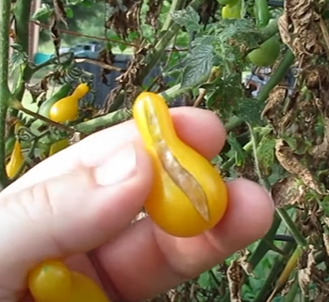
Yellow pears will grow well in any decent soil which is well-drained, fertile loam with a pH of between 5.8 to 7.0. These conditions are just about the same for all tomatoes. Soil must be kept moist by regular irrigation or watering. As a word of caution, Yellow pear tomatoes are prone to splitting.
One way to reduce the risk of cracking is by keeping them well watered and avoiding dry, stressful conditions. Watering the tomatoes following a drought will almost always result in immediate splitting which can be widespread. This picture shows a typically cracked-on-the-vine Yellow pear tomato.
When to pick yellow pears is first and foremost guided by given days to maturity on the seed packet. Approaching adverse weather conditions such as frost and rain also trigger harvest to avoid physiological damage to the tomatoes such as splitting.
Furthermore, yellow pear tomatoes are picked when they turn bright yellow, an indication that they are fully ripe. Yellow pear tomatoes come off the vine very easy when they are ripe. Early picked yellow pears can be allowed to ripen off the vine indoors. Nonetheless, when to harvest tomatoes is not always a straightforward matter. We thus recommend our *full article here* discussing when to pick tomatoes.
While growing Yellow pear tomatoes is easy and straightforward, there is more to appreciate about growing tomatoes, in general. We recommend this guide, Growing tomatoes in home gardens, by the University of Minnesota Extension.
Yellow Pear Tomato Plant
The Yellow pear is an indeterminate tomato plant which grows as tall as 6 to 10 feet or 1.8m to 3m tall. The plant grows prolifically producing much foliage. Due to its potential height and high yield, the norm is to support the Yellow pear tomato plant with a trellis, cage or stake. Yellow pear plants are resistant to many diseases that attack tomatoes including light blight. The plants are, however, susceptible to attack by worms, caterpillars, aphids and leaf curl.
Unlike determinate Roma and dwarf tomatoes that can be grown in pots and containers, Yellow pears are not suitable for growing in pots due to their aggressive vines. Lengthy vines also entail far reaching plant root systems which would not be well accommodated in an average pot or container. Nonetheless, Yellow pear tomato plants can still perform well in the ground with very little care and maintenance such as pruning. Some growers leave the plants to do as they please on the ground without any trellising and still enjoy impressive fruit production and harvest.
Conclusion
The Yellow Pear tomato is a small bite-size pear-shaped cherry tomato with a mild-sweet flavor profile. It is used in a variety of culinary applications including salads, salsa making, pickling, canning and making preserves. The tomato is an heirloom cultivar which is thought to have developed its shape through genetics. It is an easy to grow tomato which grows prolifically even without strict care and maintenance. However, Yellow pear tomatoes are vulnerable to splitting especially following some rains.
Recommended Good Reads:
